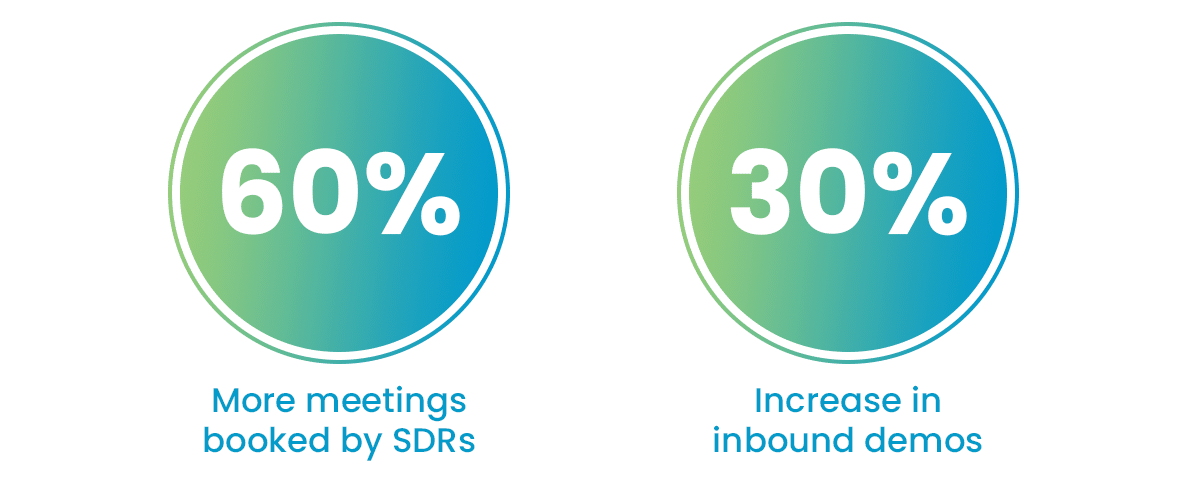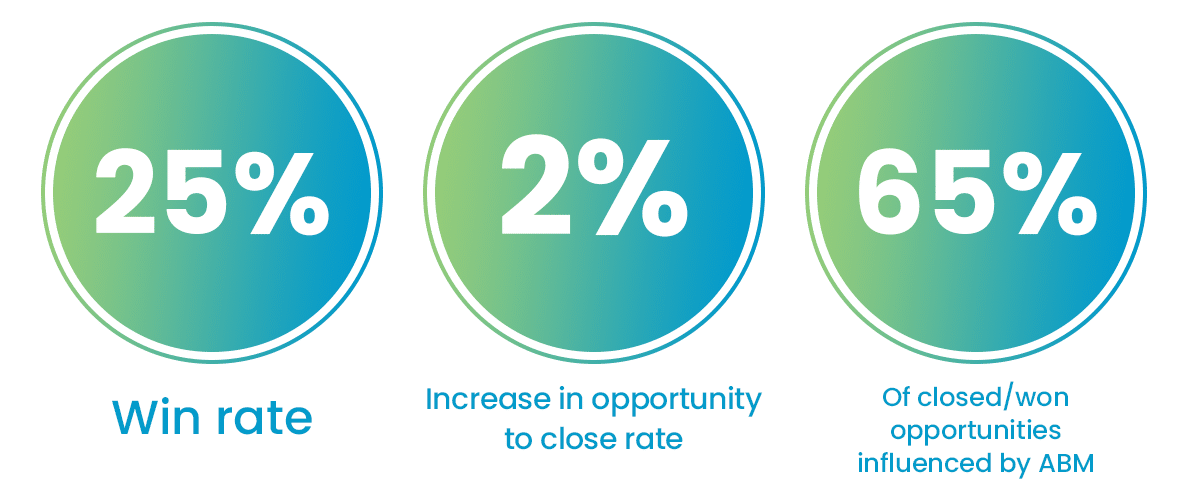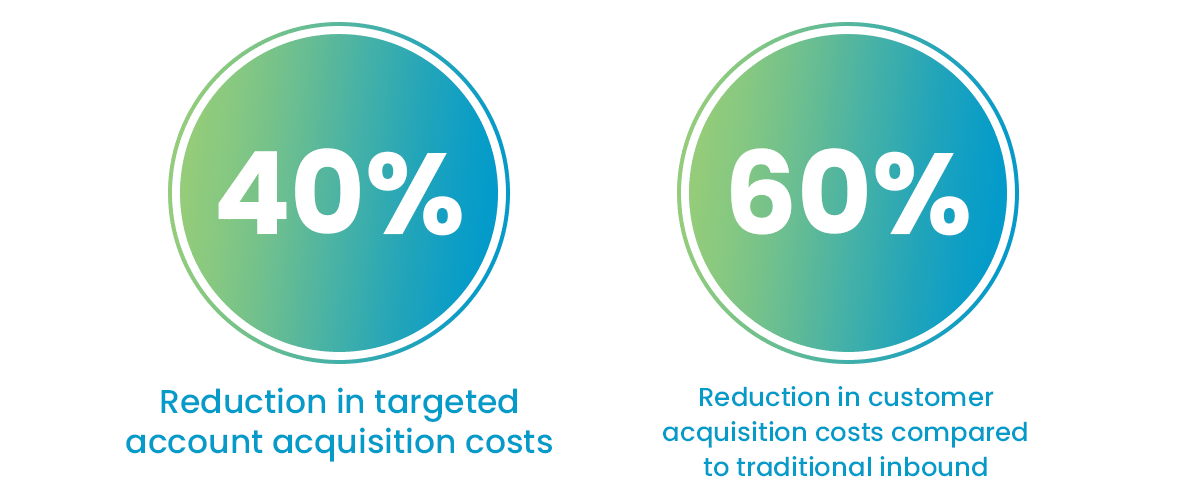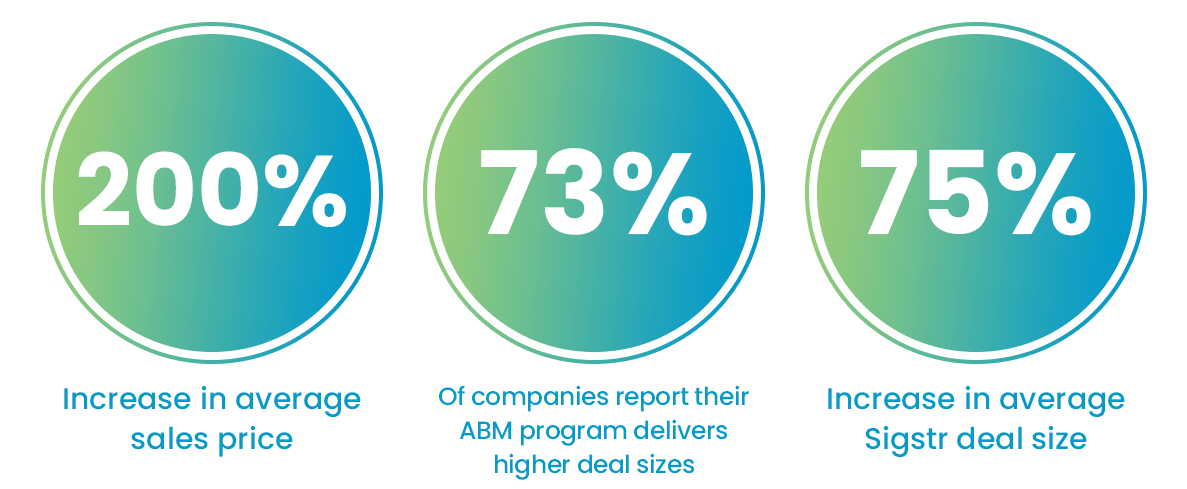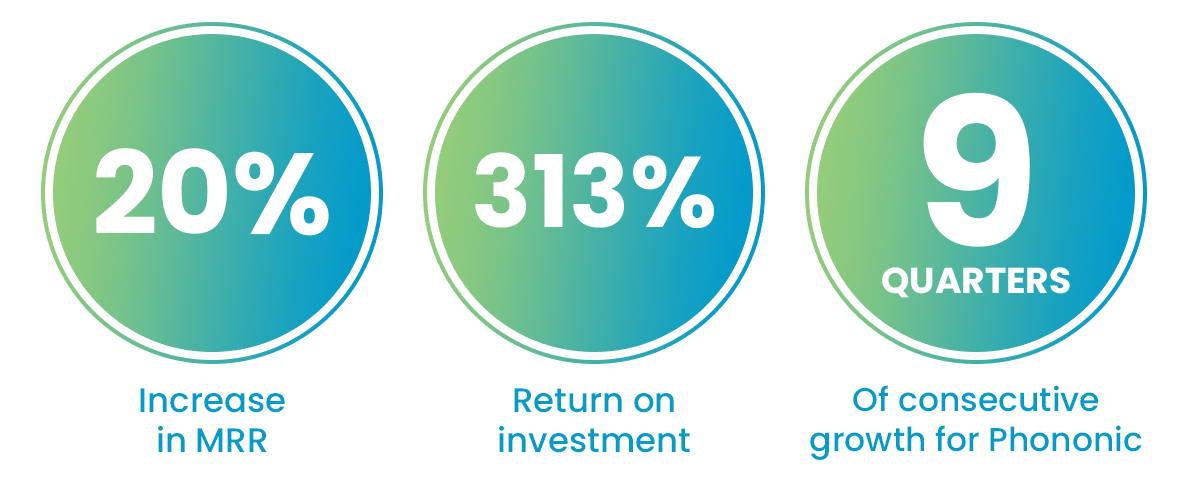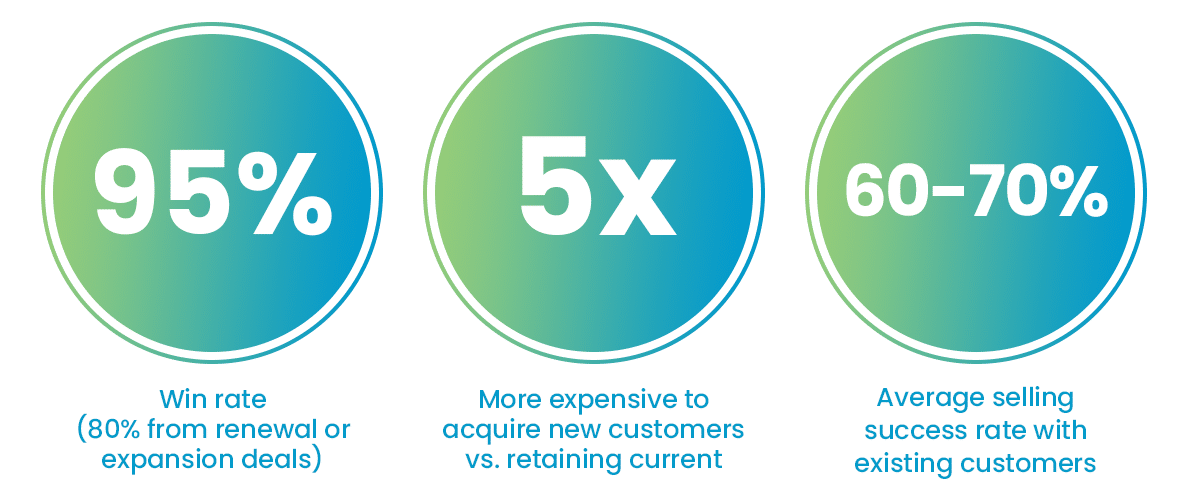Intro
As Chief Revenue Officer, your main goal is to drive revenue growth faster. This spans across all marketing, customer success, and sales teams, as you look to better integrate and align all revenue-related areas. As it turns out, account-based marketing fits perfectly with this “revenue architect” framework. Not only for bringing in net new business, but also keeping customers happy and spending more for additional products or services. When you adopt an ABM approach, you’re supporting all groups associated with the company’s revenue goals.
That’s why we wrote this blog post. To show why ABM can become a CRO’s BFF. And not just show, but also prove. Below you’ll find numbers from third-party studies, analyst reports, and real Terminus customers that all represent ABM success. Without further ado, here’s how account based marketing can impact the metrics CROs care about most.
Meetings Booked
Also Known As:
Demos scheduled, first calls scheduled, or discovery calls booked. Basically, the ability to get a prospect or customer to commit to a meeting time as it qualifies as a legitimate revenue opportunity.
How ABM Helps:
Any member of your sales or customer success team could book a meeting with a prospect or customer related to an open opportunity. However, oftentimes this responsibility lies on your sales development team. With ABM, your team can better identify ideal future customers that are looking for your solution by using behavioral data. Sales and marketing can then work together and use this data to orchestrate targeted web ads, personalized email ads, direct mail, web personalization, or any other marketing plays that “heat up” these accounts. So now your marketing team is spending their time and resources on the most important accounts identified by your sales team. And the SDRs are using behavioral data and intent data to follow up, leading to a more personalized (and efficient) approach that results in more qualified opportunities.
Numbers a CRO Will Love:
According to a commissioned study conducted by Forrester Consulting on the Total Economic Impact™ of Terminus, a sample set of Terminus customers reported 60% more meetings scheduled by SDRs. In a separate study, One Terminus customer in particular saw a 30% increase in inbound demos after only 30 days of using ABM and one specific intent topic. What would a 30-60% lift mean for your sales and marketing team?
Sales Velocity
Also Known As:
Pipeline velocity, deal velocity, time to close, or simply just time spent in the sales cycle. By understanding how quickly accounts move through your sales funnel, teams can forecast more effectively, provide more accurate revenue projections, and optimize the process. All music to the CRO’s ears. When we say sales cycle, we mean the total time spent from opportunity creation to close date or total time spent in each opportunity stage.
How ABM Helps:
Historically, marketing efforts stop after an opportunity is created. In an account-based organization, marketing and sales work together before, during, and after opportunity creation all the way through the sales cycle. What do we mean by that? By using ABM tactics to complement the one-to-one conversations your sales team is having with an opportunity, you can reinforce the message sales is sending AND reach more decision-makers at those accounts. Get the right content in front of your most important stakeholders at the right time, educate other stakeholders on your product or service to avoid future roadblocks, or use intent surges to know which topics your accounts are researching.
Numbers a CRO Will Love:
Enough with the marketing tactics, let’s get to some numbers. After interviewing a sample of businesses who have implemented ABM, Gartner reported that interviewees saw up to a 28% increase in deal velocity. Before Sigstr was acquired by Terminus, they were active users of the platform with a fully operational ABM strategy. After one year – going from no ABM program at all to award-winning ABM program – they shaved 5 days off their average sales cycle (50 to 45). Not only that, another Terminus customer (Pramata) reduced their average deal time by 32%.
Bookings
Also Known As:
New customer logos, upsell contracts, and renewal contracts. Note that we’ll focus on revenue and customer retention later on in this post as they each deserve their own section. This is to show how ABM can simply generate more opportunities for your sales team with your most important prospects and customers.
How ABM Helps:
With ABM, you have access to the audiences, the channels, the signals, and the numbers your team needs to recognize and generate more “closed/won” contracts. Sales works closely with marketing to start prospect or customer conversations at the right time. Then both teams can view the entire revenue journey and see how every sales and marketing touchpoint impacted the new booking.
Numbers a CRO Will Love:
Interviewees (from the same Gartner report mentioned earlier) who have implemented ABM reported up to a 25% win rate with targeted accounts. Whereas traditional “overflow the top of the funnel” methods usually only see a 1% win rate. Also in the commissioned study conducted by Forrester Consulting you’ll find that a composite organization with a 10% opportunity close rate improved to 12% in year one. While a 2% increase doesn’t seem very large on its own, the compound value on large contracts can result in a lot of additional revenue (year one $79,000, $119,000 in year two, and $158,000 in year three, for a risk-adjusted PV of nearly $289,000). Lastly, back to Sigstr and their award-winning ABM program. After just one year, they found that 65% of all deals won were impacted, in some way, by their account-based marketing efforts.
Customer Acquisition Cost (CAC)
Also Known As:
Average cost per acquisition, or simply, “how much are we paying, on average, to acquire a new customer?”
How ABM Helps:
Traditional demand gen tactics “cast a wide net” as teams invest a lot of resources and time in appealing to everyone in an attempt to generate as many leads as possible. This leads to way too much investment in bad-fit leads and drives up your CAC in the process. An ABM approach focuses your resources and budget on just the personas and accounts that fit your ideal customer profile. That means less money wasted on bad leads and more efficiency with team resources.
Numbers a CRO Will Love:
“I cut my costs by half and more than doubled my results.” – Head of ABM, Business Services Provider featured in Total Economic Impact™ of Terminus.
The quote above is from the same Forrester Consulting study we referenced earlier. It also states that the pre-Terminus cost for each targeted account was $150 for the composite organization, and after the cost dropped to less than $90 over a three year period by reducing wasteful ad spend and increasing engagement with target accounts. That equates to a 40% reduction in targeted account acquisition costs. Terminus customer, Pramata, also reported a 60% reduction in average acquisition cost compared to traditional inbound leads.
Annual Contract Value
Also Known As:
The average annualized revenue per customer contract. Or, the average amount a customer is spending to use your product or service on a yearly basis.
How ABM Helps:
Who is more likely to be open to investing in a higher-priced package? An account that fits within your ICP (which takes the best attributes from your current customers) and is actively researching your solution? Or that one random lead from a recent webinar where they reluctantly took a demo and now just wants to hear about your entry-level package? ABM gives your sales teams more opportunities with higher qualified accounts (who also take less time to close).
Numbers a CRO Will Love:
Interviewees from the Gartner report reported that they saw up to a 200% increase in average sales price for one segment (based on a sample of businesses who have implemented ABM). According to this SiriusDecisions study, 73% of companies reported that their ABM programs deliver higher deal sizes. After one year of using the Terminus platform and fully adopting ABM, Sigstr saw a 75% increase in ACV.
ARR or MRR (Or Both)
Also Known As:
Whether you measure ARR, MRR, or any other RR, we’re talking about the most important number here. Revenue!
How ABM Helps:
ABM is not for sales and marketing teams that want to generate leads, it’s for teams that want to generate revenue. From acquisition to renewal to expansion, teams use ABM to focus on revenue growth at every stage of the funnel. Find the right accounts to target, use multiple channels for personalized engagement, provide full visibility to your sales team on these engagements, then measure what moves the needle the most (and then do more of that).
Numbers a CRO Will Love:
Also included in the Gartner report is a stat that says those who have implemented ABM reported up to a 20% increase in monthly recurring revenue. A “composite organization” practicing ABM would experience benefits of more than $2.1 million over three year versus costs of less than $520,000, adding up to a net present value of $1.5 million and an ROI of 313%. This is according to the previously mentioned commissioned study conducted by Forrester Consulting on the Total Economic Impact™ of Terminus. For Phononic, a manufacturer of cooling and heating technology, ABM has powered nine consecutive quarters of growth for their sales and marketing team.
Customer Retention and Expansion
Also Known As:
Avoiding customer churn (especially during a downturn or uncertain times with the economy), preventing competitors from taking your customers, retaining high-value customers, and generating revenue growth opportunities with your best customer accounts. During these times, our CEO says it best, “customer retention is the new acquisition.”
How ABM Helps:
Terminus gives marketing and customer success teams endless ways to stay in front of their most important customers. You can use multiple channels to precisely target customers and drive awareness for new product features, customer events, training, or upsell opportunities. Intent data can show you when a customer is researching a competitor. And relationship data surfaces email and calendar patterns between your team and your customers, letting you know if the customer relationship is strong or slipping away.
Numbers a CRO Will Love:
Thomson Reuters used ABM to organize prospects and customers by fit, deal size, and buying cycle stage. This led to a 95% win rate, 80% of which was from renewal or expansion opportunities. That’s pretty significant considering the fact it’s five times more expensive to acquire new customers versus retaining current ones (according to OutboundEngine). Not only that, the average success rate of selling to a current customer is 60-70%, compared to a 5-20% success rate of selling to a net new customer or prospect.
The Last Word
Although it’s in the name, ABM is not just a marketing thing, it’s an everyone thing. And by everyone we mean the sales team, marketing, customer success, support, and (most importantly) the c-level. Account based marketing connects, aligns, and integrates all revenue-related areas into focused and efficient growth.
Owning a revenue number (or all revenue-related numbers) is also becoming an everyone thing. So if you’re a CRO, isn’t it time you consider ABM?
